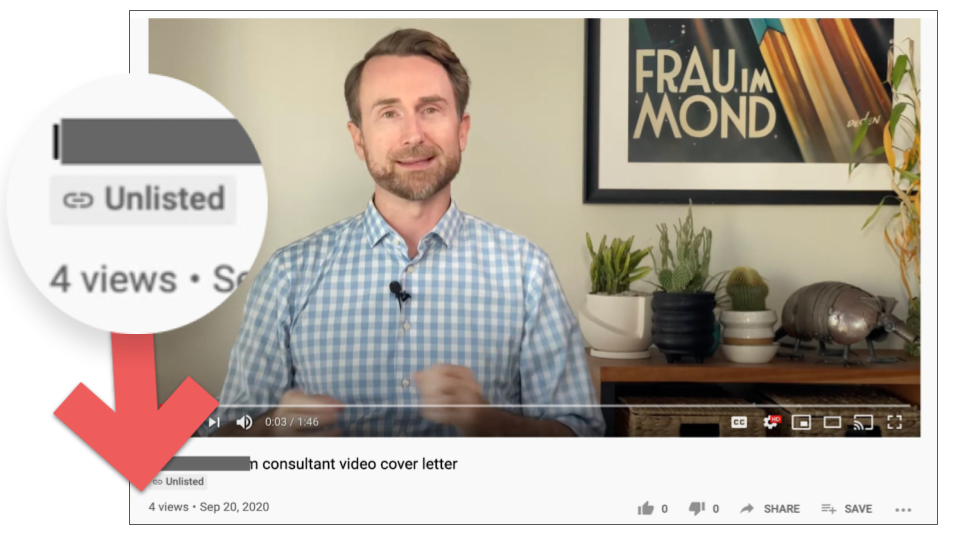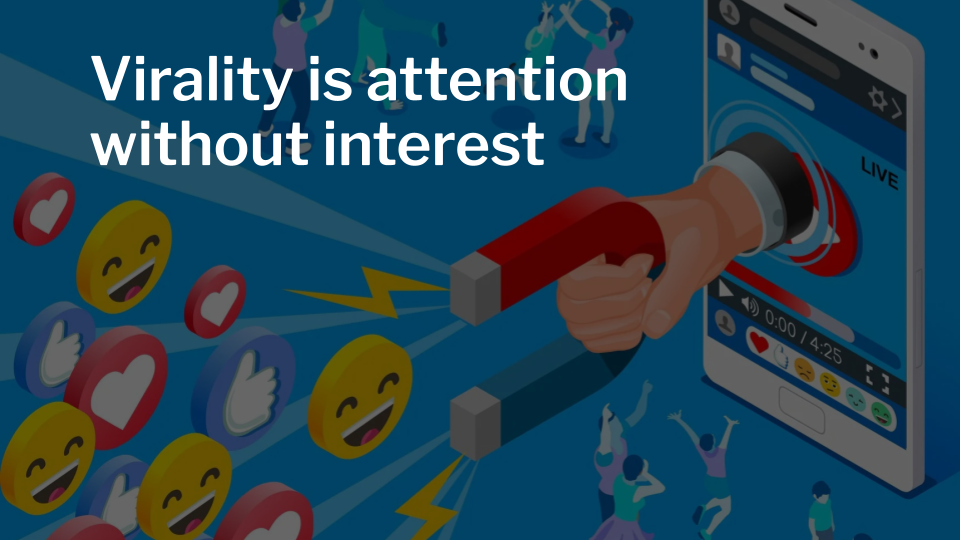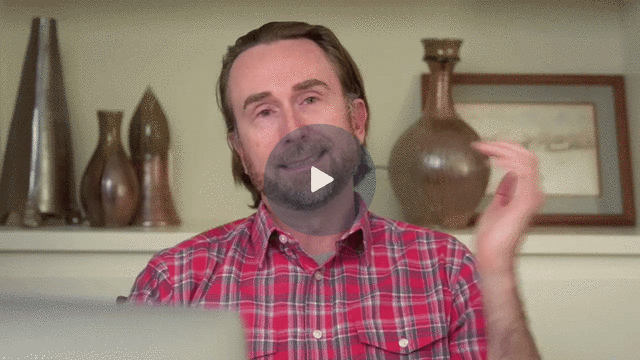
Table of Contents
I. Virality is Attention Without Interest
II. Go Small to Go Big
III. Ditch Youtube for Loom
IV. What’s In It for Them?
V. Three Levels of Production Value
VI. Next Steps
Going viral is a distraction.
Personalized videos to small audiences will change your life by winning you gigs, customers, and connections.
I have a confession. I’ve taught thousands of people how to make videos but I’ve never had anything go viral.
My most watched video has 20,000 views. That is chump change if you’re a full-time content creator. This used to give me an insecurity complex. How can I be teaching this stuff if I’ve never made it big myself?
Then I reminded myself that going viral is winning the wrong game. I’d rather play a game that few others are playing.
I’m not trying to command attention for attention’s sake. I want to command attention because I want my work and my ideas to resonate on deeper levels.
If you’re looking to do something similar—i.e. create outsized impact with your expertise—know that big view counts for your videos might be equally unhelpful.
I’ve spoken with big time Youtubers who have gone viral multiple times. And they say the same thing: going viral isn’t all it’s cracked up to be. These same Youtubers have 8-figure subscriber counts. They get millions of views. But when they try to sell their product or monetize their work, the results are disappointing.
I. Virality Is Attention Without Interest
I have a devastatingly handsome friend. He’s a tall, Latin lover-type with a megawatt smile. A waitress once screwed up our lunch orders because the gravitational field of his attractiveness short-circuited her ability to do her job.
He wants to be in a long-term relationship. Yet his love life is awful.
He’s drowning in attention from women, but they’re all interested in him because he’s 99th percentile handsome. None of them are interested in getting to know the real him. They want arm candy or a fun fling.
He’s getting attention without interest.

This is what it’s like for your content to go viral. Lots of eyes on you…without anyone interested in engaging you more deeply, whether it’s buying your course, learning about your work, or grappling with your ideas.
Viral videos are the one-hit wonders of ideas.
Takeaway: Big numbers of views do not correlate with big impact.
II. Go Small to Go Big
Some people’s videos go viral and one week later, after their inboxes have exploded, life goes back to normal.
The video that changed my life was seen by four people. But those four people were in charge of selecting who would get a $52,000 consulting contract.
I sent a “video cover letter” along with my bid for the project. When I closed the deal, my client made it clear: the video is what made my proposal stand out from the others.
The $52,000 was huge!
But the money wasn’t even what lit me up the most. Even bigger was the the feeling that washed over me when I realized that this strategy was repeatable.
“This is just the beginning,” I thought!
And so it was.
In the years after, I used short videos to add a little oomph anytime I was aiming for something big. The results were incredible:
💸 Closed a $52,000 consulting gig with a 90-second video
🎙 Landed a spot on a nationally-syndicated NPR show
🤝 Established trajectory-shifting partnerships with Apple, Youtuber Ali Abdaal, General Assembly, and Maven
🙋🏾♂️ Secured internet rockstars Sahil Lavingia (Gumroad CEO) and Dickie Bush (Ship30for30) as guest speakers in my Minimum Viable Video and University of Texas courses
🏝 Paid speaking gigs in the Caribbean:

About the time I started Minimum Viable Video—my course for entrepreneurs to learn video—I sent a personalized video to Ali Abdaal, a Youtube star with four million subscribers. He was starting his Youtube-focused course (The Part Time Youtuber Academy) at the same time I was starting Minimum Viable Video.
The cold outreach video I sent to him suggested a few ideas for how we might collaborate. It was the beginning of a successful partnership where he taught me the ins and outs of Youtube and I taught him how to run online courses. We guest spoke in each others’ courses for years.

Videos created for smaller, specific audiences are a secret weapon to cut through the noise and create opportunities.
This strategy works for sparking the interest of leadership teams at organizations you want to work with, decision makers at companies you want to work for, and industry leaders you want to collaborate with.
How are these videos different than what we see on Youtube?
Standard Videos | Personalized Videos | |
|---|---|---|
| Audience | Decided by an algorithm | Decided by you |
| Duration | 5-10 min | <2 min |
| Production | High effort | Low effort |
| Editing | Heavy | Light |
Small audience: Aimed at an individual or small team.
Short duration: Always shorter than two minutes.
No editing: These are single-take, one-and-done videos.
Messaged, not posted: While most videos are posted publicly for the world to see, personalized videos reach their targets through DMs and emails.
Outcome-oriented: The average Youtuber’s goal is to increase views and watch times. In contrast, personalized videos are a call-to-action: an invitation to respond, book a calendly, or start a conversation about working together.
Takeaway: What makes a good personalized video is different than a public-facing video shared to the world.
III. Ditch Youtube for Loom
Youtube makes money through advertising, which means that all product decisions are designed to drive maximum eyeballs to Youtube. More people watching more minutes of video is the goal. This is a product built for maximum scale: billions of views, low engagement.
Personalized videos are the opposite. We’re making a video to engage one person on a deep level so we can work towards a Zoom conversation, an in-person meet, or a project collaboration.
And that’s why Loom is the right tool for the job.
Loom’s business model runs on a monthly subscription. Loom is built for business people and busy professionals who want to leverage video, not full-time influencers or content creators.

Product decisions at Loom converge towards simplifying the ease and simplicity of creating videos for single-digit view counts.
Features such as auto-upload (imagine never having to mess with video files again!) and auto-copying the video’s link to the clipboard reveal the care and concern for the video creator.
Note how many more steps are involved when you use Youtube:
| Youtube: 7 Steps | Loom: 3 Steps |
|---|---|
| 1. Hit record | 1. Hit record |
| 2. End recording | 2. End recording |
| 3. Find file | 3. Send link |
| 4. Upload file to Youtube | |
| 5. Set link to “unlisted” so it’s not public | |
| 6. Copy Link | |
| 7. Send Link |
Note: Loom has a non-watermarked free version so you can get enormous value from this product and never actually pay for it.
(In case you’re wondering, why are the videos above screenshots from Youtube instead of Loom? That’s because I only started using Loom two years ago).
Takeaway: Loom makes it frictionless to create personalized videos.
IV. What’s In It For Them?
You don’t need a letter-perfect script or elegant delivery to make a great personalized video. But your message is critical.
There is one crucial guiding principle to crafting your message that, more than anything else, determines the success of a personalized video: WIIFT.
WIIFT stands for “What’s in it for them?”
The point of a personalized video is not for the recipient to understand you, your story, or your work. Those things matter! But before you get to them, you must establish how you, your story, or your work could benefit them.
Marketing to large audiences is hard because you have to create a message that scales. It MUST resonate with a large segment of people.
Personalized videos are so much easier. Because it’s targeted at one person, you only need it to be interesting to that individual. A little bit of googling and foreknowledge of what they care about is all you need. Viral videos, because they are seen by millions, cannot be personalized.
Here are simple ways to do that:
- Complimenting their work: everyone loves heartfelt words about what they do. If you compliment them and tell them what parts of their work resonated, you’re not only giving them warm fuzzies but also giving them more data points on what’s working.
- Unsolicited testimonials: now you’re doing the above along with giving them an asset that will help them succeed in the future.
- Feedback: Suggestions for what would make their work even better
- Content ideas: “your work makes me think of [x], which is related to your work because of [reason].”
- An article or video that might be interesting
In the next section we’ll talk about production value and how sharing the above comes across as more genuine, heartfelt, and authentic than if you achieve Netflix-doc production value.
Remember that these videos are under two minutes, so you’ll find that the time you spend talking about yourself gets pretty tight.

What does this look like in practice?
Let’s examine the outreach I sent to Dickie Bush, an online writer with 186k Twitter followers, to guest speak in one of my courses.

It started with a very short Twitter DM.
Note how I explicitly state the low commitment on his part (watching the video only takes 60 seconds) and namedrop credibility (association with the University of Texas):

Here’s the video:

Takeaway: Great personalized videos are about the recipient, not the person on camera.
V. Three Levels of Production Value
Production value—lighting, audio, and background—is crucial if you’re trying to trend on Youtube or get your videos on Netflix.
But if success is creating a connection to one person, high production value is not a requirement.
See below for a breakdown of three approaches, ranked from low effort to high effort, to production for personalized videos.
No Effort: Just Hit Record
TikTok and Instagram, the fastest-growing video platforms in the world, are evidence that people have no problems watching videos with low production value. These platforms normalized poor lighting and no editing.
Part of their success is that no-production value videos are relatable. Overly produced content can seem stiff and stilted. The authenticity of no production allows you to connect with the recipient.
This approach means almost ignoring audio, lighting, and your background. (Maybe don’t ignore audio completely. If you’re background is noisy and the recipient has to strain to understand your words, you’re doing it wrong.)
Fire up the Loom app on your phone or your computer and start talking to the camera. If what you say is sufficiently WIIFT-y, passionately delivered, and ungarbled, chances are good you’ll get a response.
The upside of no production is that it’s maximally efficient. What this means is you have more time to create more videos aimed at other recipients. Success with personalized videos is largely a numbers game. The more videos you send, the better your chances. Said differently, sending 10 no-production videos to 10 different people will yield better results than spending hours on extremely high production for a video to one person.
Read more: A short video on how to film with better production value with no gear.
Low Effort: The Walk-and-Talk
Walk-and-talks are a simple way to take personalized videos up a level. This approach involves going outside and talking to the camera in selfie mode as you walk. Why is this better?
If you’re outside, you’re getting natural light. Everything looks better in natural light. A pro tip is to record during the Golden Hour—the thirty minutes just after sunrise and before sunset. Sunlight is soft and diffuse at this time, which means it’s almost impossible for your footage to look bad. Golden Hour is the cinematographer’s favorite time of day. Filmmaking legend Terrence Malick literally filmed an entire feature film during the Golden Hour because he was so enamored with this light.

The second big advantage is that by recording while walking, your background is shifting and changing with each step you take. This causes the shot be more dynamic and interesting, and separates your footage from the static, low-effort look that plagues the Zoom grid.
Things to look out for: stay away from noisy environments and don’t record while crossing busy streets.
Pro Effort: High Production Value
If we’re not professional Youtubers, why should we care about strong production values?
There is a time and a place for high production value in personalized videos.
Rory Sutherland, consumer psychology expert and ex-GM of Ogilvy, said it best: “We can’t help but assume the importance of a message is proportional to the cost of delivering it.”
When you know that someone went to great lengths to get a message to you, you assume the content of the message is important.
This is why receiving a hand-written letter—as opposed to an email, which is so easy to fire off—makes the recipient feel special. This is why young men buy a dozen roses for their love interests. They know that the recipient will understand that he had to go to the florist, pick out the bouquet, and schlep it around until he presents the flowers. This is why cooking someone a meal will always be more appreciated than bringing takeout, because cooking the meal requires more effort than ordering takeout.
If you take the time to create a proper home studio setup, your viewers will register the effort you went to do so. A home studio signals that you care enough and are serious enough to invest in production value, which signals that your message is worth taking seriously.
Unpacking how to achieve high production value is beyond the scope of this piece (join my newsletter or take my course if you want to learn that. But for the most important messages, it’s worth considering.
Takeaway: Production value is of lesser importance in personalized videos, but it still brings benefits.
VI. That’s a Wrap
You made it!
We’ll use a video to close it out and share a few words on next steps.
Thanks to: Nate Kadlac, Chris Wong, Promeet Mansata, Danny Naz, Karena de Souza, Leo Ariel, Charlie Becker, Anthony Polanco